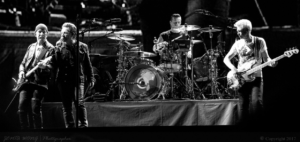The Tradition of the Ceilidh in Irish Culture: Unveiling Its Social Significance
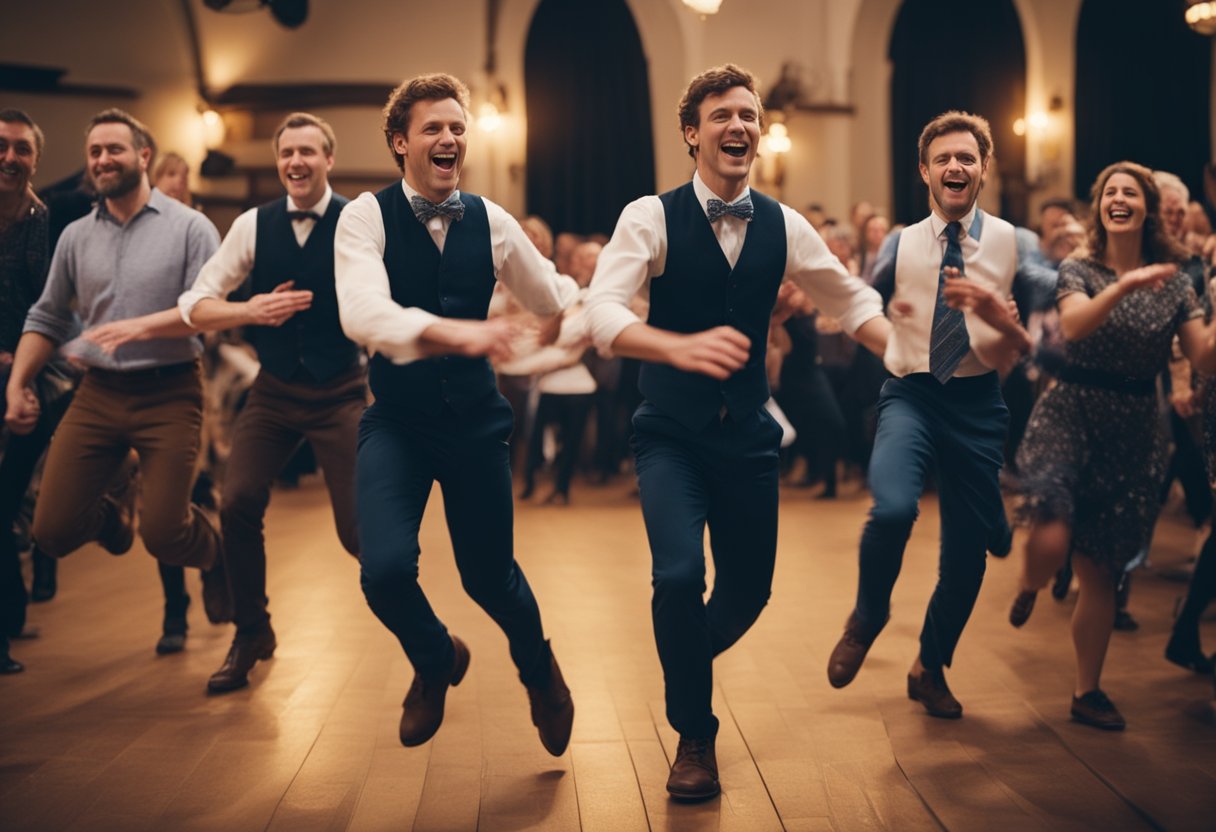
Updated On: April 22, 2024 by Maha Yassin
The ceilidh tradition is a cornerstone of Irish culture, reflecting the vibrancy of its community life and the depth of its traditions. Ceilidhs are social gatherings encompassing music, dance, storytelling, and more—integral to the fabric of Irish life. These events serve as entertainment and a crucial means of fostering community spirit and maintaining the national identity. With a history that intertwines with the nation’s past, ceilidhs epitomise the Irish love for celebration and camaraderie.
Irish ceilidhs are steeped in cultural heritage and serve as a vehicle for passing traditions from generation to generation. They are synonymous with traditional music and dance, strongly tied to community life where everyone, from the youngest to the oldest, partakes. As we navigate through the nuances of these gatherings, we understand their role as a social hub where language, folklore, and collective memory thrive. Today, while the ceilidh remains true to its roots, it continues to adapt, ensuring its relevance in contemporary society and beyond Ireland’s shores.
Historical Context of Ceilidhs

As we explore the ceilidh tradition, it is crucial to understand its rich historical tapestry—rooted in the communal and cultural expressions of Celtic and Gaelic societies in Scotland and Ireland.
Origins and Evolution
The ceilidh (pronounced ‘kay-lee’), a term from Old Irish, originally referred to any social gathering, not limited to those involving dance or music. Its essence was communal, encompassing storytelling, recitations, music, and debate, fostering unity and identity. Over time, these gatherings began incorporating dancing and musical performances, evolving into a hallmark of social life in Scotland and Ireland. The modern ceilidh retains this core aspect of community, often held in local halls or at family events, continuing the communal traditions of the past.
Celtic and Gaelic Influences
Celtic traditions, especially those with roots in Gaelic culture, have significantly influenced the development and perpetuation of the ceilidh. This can be seen both in the types of dances performed and the traditional Gaelic music accompanying them. Classic Gaelic dances such as the reel, jig, and strathspey remain staples of ceilidh dancing, reflecting the melding of historical customs with contemporary enjoyment. As a cultural fixture in Scotland and Ireland, ceilidhs exemplify the enduring legacy of Celtic and Gaelic influences on celebrations of heritage and community life.
Music and Dance at the Ceilidh

Music and dance intertwine at the heart of a ceilidh to create an experience that fosters community and joy. Traditional instruments set the tempo for various group dances, allowing individuals of all skill levels to partake.
Common Instruments
Traditionally, ceilidh music is characterised by a lively groove, with a prominent role played by the fiddle. This instrument’s versatility brings to life the melody of tunes, ranging from the spirited jigs to the flowing reels. Another staple is the accordion, offering rich, resonant chords and maintaining the rhythm that drives dancers across the floor. Guitars are utilised for their rhythmic strumming, while the tin whistle’s high-pitched notes slice through the ensemble, adding a bright, piercing quality to the music.
Traditional Dances
Ceilidh dances are a cherished part of Irish social gatherings. One favourite is the barn dance, a simple dance perfect for beginners yet delightful for experienced dancers. Additionally, ceilidh dance is not one dance but a collection; its structure is conducive to group participation, promoting unity and camaraderie. Meanwhile, step dancing injects individual flair into the proceedings, corresponding closely to the music with a precise footwork that mirrors Irish dance’s detailed tradition.
Ceilidh as a Social Hub
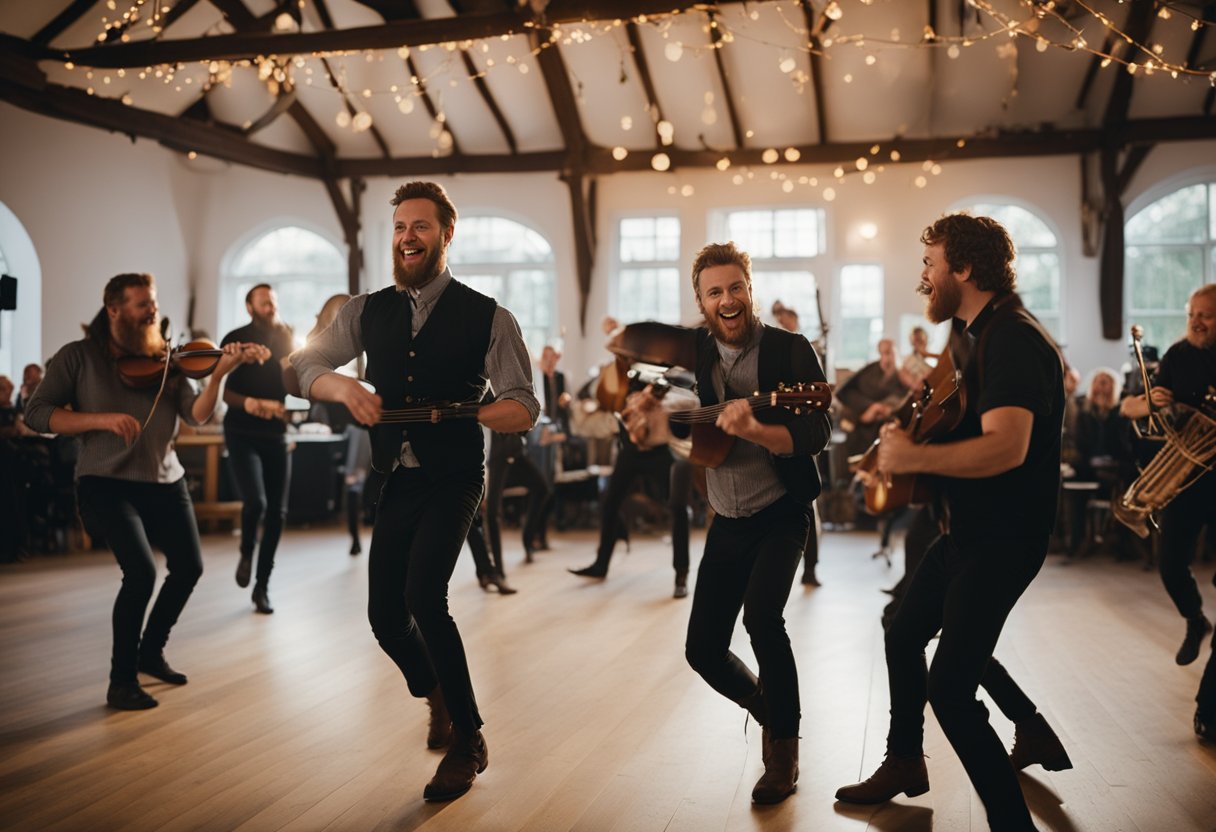
In the heart of Irish culture, the ceilidh serves as a dynamic social hub that strengthens community bonds and bridges generational gaps.
Community Cohesion
Ceilidhs have long been integral to fostering unity within Irish communities. These gatherings act as vibrant social melting pots where the young and old, families and friends converge. The practice of sharing songs, dances, and stories not only entertains but also fortifies the collective identity of the audience. Here, the art of courting often unfolds, burgeoning into relationships that might eventually blossom into marriage, further entwining the lives within these communities.
Generational Connections
Remarkably adept at connecting disparate generations, ceilidhs offer a common ground for the youth and the elderly to share their love for Irish tradition. Such events provide a platform for passing down age-old tales and traditions, ensuring that the rich tapestry of Irish culture is not lost to time. The ceilidh’s welcoming atmosphere allows for the free flow of wisdom and love between generations, as experienced members lead dances and songs while younger attendees absorb and learn.
Language and Storytelling

In Irish culture, the ceilidh exemplifies the vital role of Gaelic as both a language and a medium for storytelling. We explore how tales and poetry are passed down, enriching the tapestry of Ireland’s literary heritage.
The Role of Gaelic
Gaelic is the lifeblood of the traditional Irish ceilidh, serving as a cornerstone of cultural identity and communication. Language is more than a mere tool for expression—it embodies a community’s history, values, and collective memory. At a ceilidh, it’s common to hear ballads sung and stories told in Gaelic, a language that encapsulates the essence of Ireland’s rich lore. Learning and sustaining the Irish language has been, and continues to be, a central part of preserving this precious facet of our culture.
Tales and Poetry
Tales and poems shared at a ceilidh are paramount in conveying the narratives of Irish life, with storytelling acting as a bridge to our ancestral past. The stories often include elements of myths, legends, and the supernatural, reflecting a profound understanding of our natural environment. Poetry, notably, comes alive in this setting—rhythmic and evocative, it’s an oral art form that resonates with the listener’s heart. Each stanza and verse from the seanchaí—the traditional storyteller—transports us through Ireland’s storied landscape.
Ceilidh in Modern Times
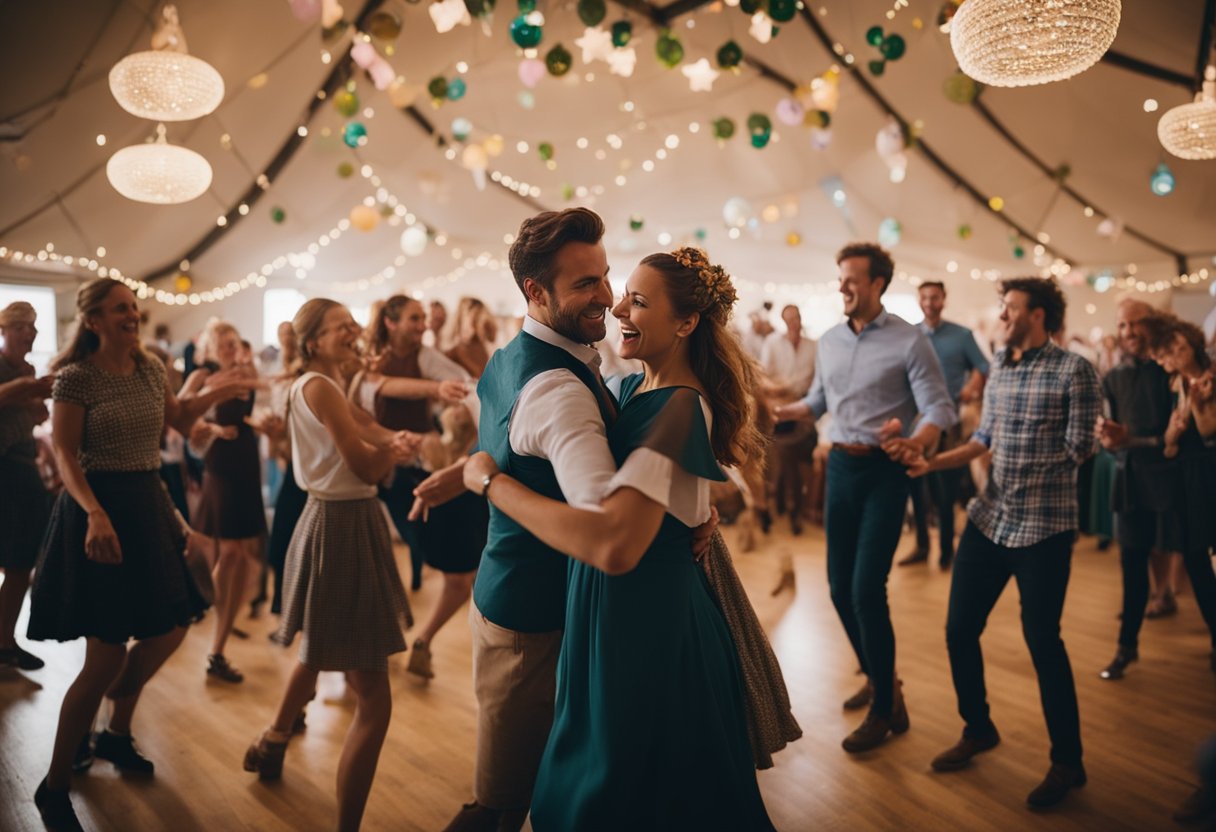
The ceilidh tradition thrives, adapting to contemporary settings while preserving its communal spirit.
From Rural Roots to Urban Settings
Ceilidhs have transitioned from their rural origins in Irish and Scottish culture to urban settings, finding a new home in cities worldwide. These social gatherings, rooted in folk music and Scottish country dancing, have been embraced within various institutions, including universities, serving as a vibrant hub for students to engage with Celtic heritage. The ceilidh’s adaptability has ensured its presence in modern society, with dances and music now a familiar feature at city-based cultural events, seamlessly integrating into the social fabric of urban life.
Adaptation and Resilience
The endurance of ceilidhs showcases the resilience and dynamism of this tradition within the diaspora. Irish culture, alongside its Scottish counterpart, often reverberates through ceilidh events via the spirited performances of Celtic music. Despite changes and challenges, ceilidhs have remained steadfast—a testament to the inherent adaptability of cultural expressions. These gatherings continue to unite communities, offering a slice of home and heritage far from their ancestral lands and demonstrating the power of ceilidhs to bring joy and connection to those who participate.
Cèilidh Across Borders

Cèilidhs have transcended their Gaelic origins to weave a thread of communal joy through various cultures around the globe. This section unpacks how the tradition has been embraced internationally and its impact on various folk customs.
Global Celebrations
In countries such as Canada, Australia, New Zealand, and the United States, vibrant diasporas have nurtured the cèilidh tradition, shaping it into a cornerstone of cultural identity for many. In these nations, it’s commonplace to find cèilidhs acting as hubs for community connection, often featuring traditional Irish and Scottish dancing and local adaptations that reflect the unique character of their host cultures.
Celebrations in these countries frequently commemorate significant dates such as St. Patrick’s Day or, in the case of Scotland, Burns Night. These events serve as a touchstone for expatriates, creating a sense of home away from home, and for others, they offer an immersive experience of Celtic heritage.
Influence on Other Folk Traditions
The cèilidh has assertively influenced other folk traditions, evident in regions like Wales, where the towpath (dance party) shares similarities. In Cornwall, the nos lowen or ‘happy night’ echoes the convivial spirit and collective dances of the cèilidh.
Perhaps one of the more direct influences can be found in English country dance, a form of folk dancing that shares historical roots and dance figures with the cèilidh. As cèilidh dancing has evolved, it has both borrowed from and contributed to this tradition, illustrating a rich interchange between cultural practices. Whether it’s a reel in a village hall or an international festival stage, the essence of the cèilidh embodies a universal celebration of folk culture.
Cultural Significance and Identity

The ceilidh tradition profoundly reinforces national identity and interweaves cultural heritage across Ireland and Scotland. It’s an emblem of shared stories and communal resilience that spans generations.
Cèilidh as a National Symbol
The ceilidh is more than just a festive gathering; it encapsulates a vital piece of our cultural heritage. In Ireland and Scotland, it reaffirms our national identity by acting as a conduit for oral traditions, music, and dance that has defined us for centuries. Particularly in Ireland, the ceilidh reinforces the Irish spirit, echoing through rural and urban landscapes and illustrating a collective memory that underpins our cultural fabric. In Scotland, similar gatherings, often termed ceòl mòr (the great music), bind communities with a shared sense of belonging deeply etched into the Scottish psyche.
Interlinking Traditions
Ceilidhs have invariably served as a nexus, intertwining various strands of our culture. In Northern Ireland, they blur the distinctions between various heritages, fostering a sense of unity amidst diversity. These gatherings are not merely dance events; they are stages for passing down traditions, with each tune and step rooted in a history that has been carefully preserved. They link our past to the present, ensuring that our cultural identity resonates with the same vigour in the modern era as it did in days long past.
Traditional Gatherings
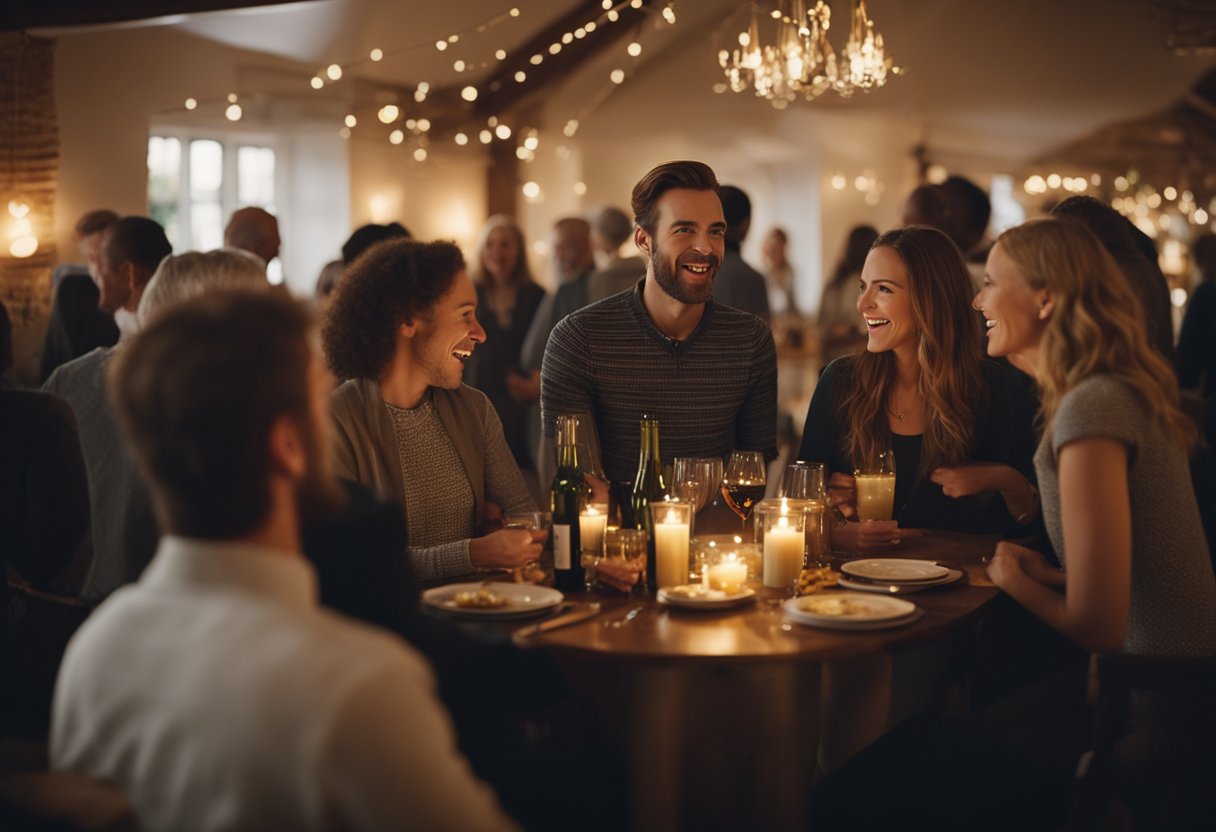
As a focal point of traditional Irish gatherings, Ceilidhs play a pivotal role in festivals and personal celebrations across Ireland. We honour the customary aspects of our Gaelic heritage, infusing them into contemporary social occasions and milestones.
Festivals and Seasonal Celebrations
Festivals mark the cornerstone of our cultural year, creating a vibrant social outlet that unites societies across the nation. Our festivities often revolve around the Celtic calendar, with highlights such as Bealtaine, ushering in the summer with fires, feasting, and merry dance. These events encapsulate our rich customs and provide a chance to celebrate with traditional music and dance, embodying the essence of the ceilidh spirit.
Weddings and Birthdays
At weddings and birthdays, ceilidhs represent a heartfelt expression of our celebratory culture. The ceilidh is an integral part of many nuptials, fostering a sense of community as families and friends join in the revelry. At birthdays and similar personal milestones, ceilidh dancing provides an engaging and inclusive form of entertainment, renewing our social bonds and honouring the personal achievements of our community members.
Cèilidh Music and Instruments
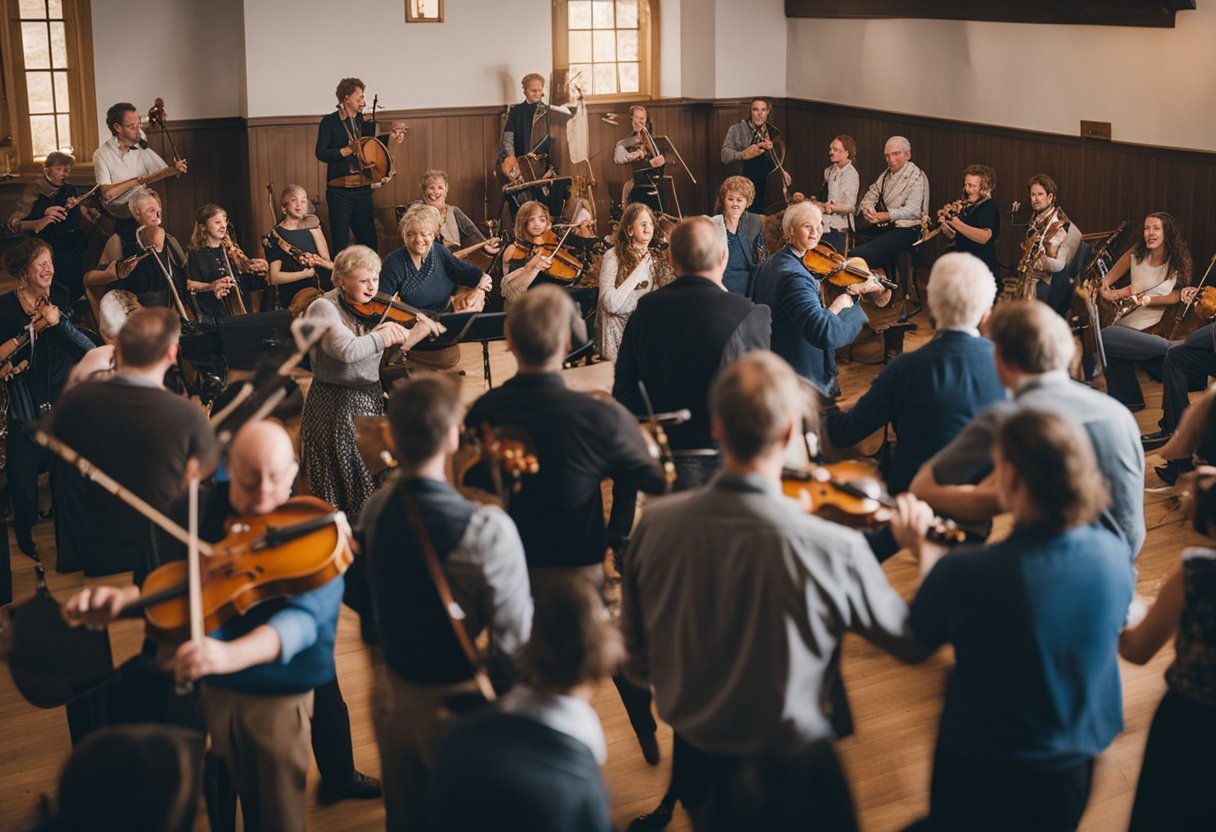
Cèilidh music is an integral part of the cultural tapestry of Ireland, showcasing a rich variety of instruments that blend harmoniously to create its distinct sound.
Instrumental Variety
The ensemble of instruments traditionally used in cèilidh music establishes the vibrant and lively atmosphere for which these gatherings are celebrated. Central to the band is the fiddle, with its elaborate melodies and ability to set the pace for dancers. The accordion provides a full-bodied richness, while the piercing tunes of the tin whistle contribute a high-pitched, spirited flair. The guitar offers rhythmic backing that grounds the music, and the bouzouki, which found its way into Irish music in the mid-20th century, adds a resonant depth with its long-necked, stringed vibrance.
Drums and the bodhrán, a traditional Irish frame-drum, are the heartbeat of cèilidh music, creating the pulse that dancers move to. The Scottish smallpipes, a mellower cousin of the Great Highland Bagpipe, are sometimes featured, adding a haunting, ethereal quality to the music. Each instrument is essential in crafting the engaging and rhythmic experience that defines a cèilidh.
Evolution of the Cèilidh Band
Over time, the traditional cèilidh band has witnessed a remarkable evolution. While steadfast in their connection to traditional music, cèilidh bands have woven contemporary influences into their sound. Introducing instruments such as the electric bass guitar has added a modern edge. It is common to see the incorporation of diverse instruments, some extending beyond the traditional staples.
Our embrace of historical and modern influences mirrors the ethos of Connolly Cove, which celebrates the beauty of tradition while exploring global cultural narratives. The dynamism of the cèilidh band reflects the ethos of evolving tradition, just as we aim to connect our audiences with the rich tapestry of global cultural heritage and contemporary practices.
Learning and Preservation
We explore how the ceilidh tradition is maintained and taught through structured learning environments and community initiatives, ensuring this vibrant part of Irish heritage continues to thrive for generations.
Cèilidh in Education
In schools and universities across Ireland, the ceilidh tradition is vital to the curriculum, fostering a sense of community and shared cultural identity among students. Educational programmes focus on the history of ceilidh and its significance in Irish culture, with step dancing and ceilidh dances integral to music and dance lessons. Clubs within these institutions often form ceilidh groups, offering novices and experienced dancers opportunities to learn and engage with this traditional social gathering. These efforts are crucial in preserving ceilidh, ensuring it remains a living, breathing element of Irish social life.
Cèilidh Dance Classes
Outside the formal settings of schools and universities, ceilidh dance classes are common in community halls and clubs around Ireland. These classes are designed to welcome individuals of all skill levels, proving that you don’t need to be a professional akin to those seen in Riverdance to participate. The aim is to teach the steps and rhythms in a supportive environment, emphasising participation over perfection. Novices can expect to start with the basics, gradually building up to the more complex figures as they become more confident. The classes preserve the traditional dances and the social, communal spirit of the ceilidh, knitting together communities through a shared cultural practice.
The Roles and Responsibilities at a Ceilidh
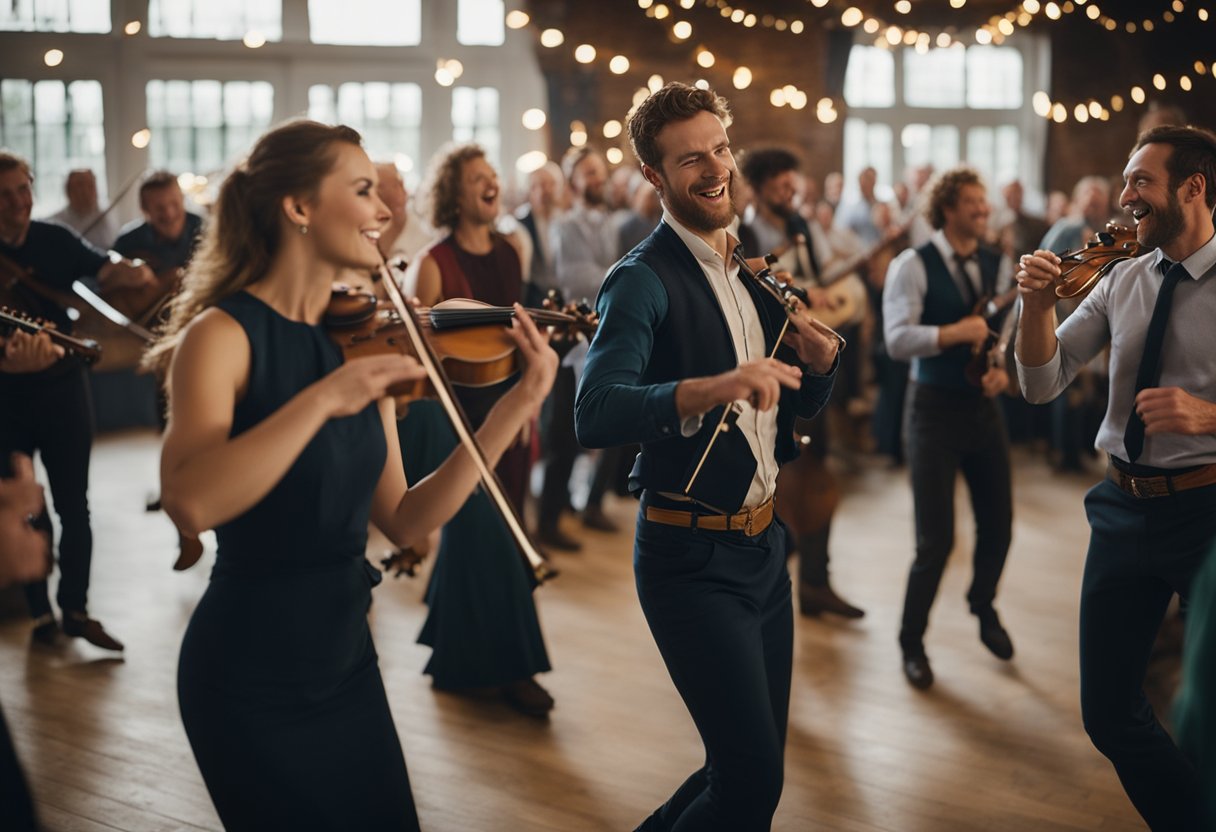
In a ceilidh, every role is crucial to the evening’s success—from the caller’s leadership to the dancers’ enthusiasm. Understanding these responsibilities enhances the community spirit and ensures a welcoming atmosphere for all participants, including novices.
The Caller and Dancers
The Caller: At the heart of the ceilidh stands the caller, whose responsibility it is to guide the audience through the dances. They not only announce the next dance, such as the Gay Gordons or Siege of Ennis but also provide instructions, ensuring all participants can follow along. Callers interweave instruction with encouragement and often tailor their guidance to suit experienced folk and those new to the dances.
- Novices: Newcomers are warmly welcomed and are typically paired with more experienced dancers to learn the steps. This mentorship is part of the ceilidh tradition, ensuring the continuation of cultural practices.
The Dancers: Participants’ roles extend beyond merely following steps. Their energy and willingness to engage with others and learn dances like The Walls of Limerick contribute to the dynamic atmosphere. Dancers switch partners frequently, fostering a sense of community and inclusivity.
- Engagement: Enthusiastic participation from everyone helps bridge gaps between experienced individuals and novices, creating a supportive environment where all feel comfortable to join.
Community and Engagement
The Community: The ceilidh is a manifestation of communal ties and shared heritage. It’s a place where tradition thrives and community bonds are strengthened. Everyone present, regardless of skill, is encouraged to partake in the festivities, supporting one another in every dance and conversation.
- Audience: Even those who choose to watch rather than dance play a part. Their applause and cheers uplift dancers and contribute positively to the communal atmosphere.
Through understanding and honouring these roles and responsibilities, we ensure that the spirit of the ceilidh remains a vibrant and integral part of our culture.
Frequently Asked Questions
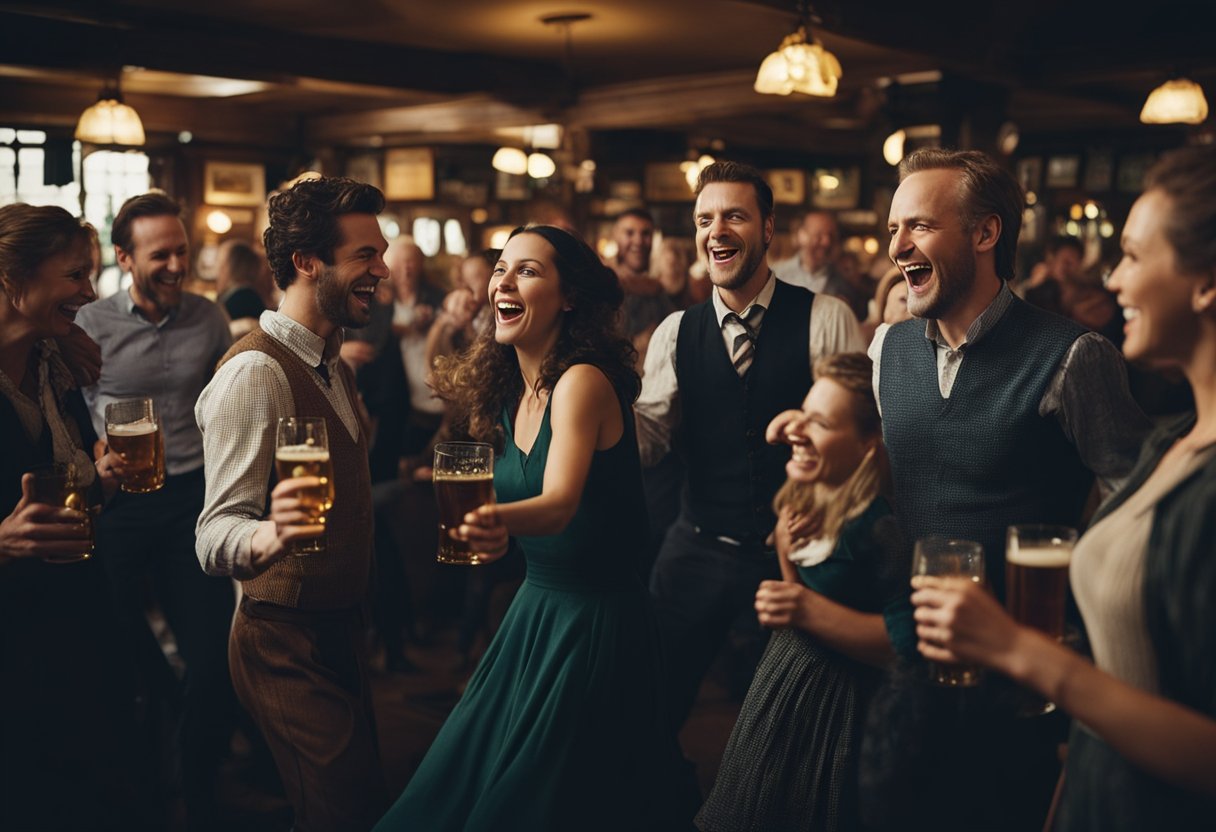
We’ve compiled the most common inquiries about the ceilidh tradition in Irish culture to provide deeper insights into its significance.
What is the purpose of a ceilidh in Irish culture?
A ceilidh serves as a vibrant social affair where the Irish community gathers to celebrate through dance, music, and storytelling, deeply entwined with their ethos of togetherness and entertainment.
How does a ceilidh differ from other traditional Irish social gatherings?
While other gatherings might focus on quiet interaction or formal events, a ceilidh is uniquely characterised by its informal atmosphere, participatory dancing, and live folk music, creating an inclusive environment where everyone is encouraged to join the fun.
What is the etymology and meaning of the term ‘ceilidh’?
The term ‘ceilidh’ is derived from the Old Irish ‘céle’ (which means ‘companion’), and it originally signified a social visit among friends and family, often involving storytelling and music.
What is the historical significance of ceilidh dancing in Ireland?
Ceilidh dancing is a tradition that symbolises the communal spirit of Ireland, with historical roots dating back to when communities would gather to socialise and share stories, strengthening social bonds through dance and song.
How has the tradition of the ceilidh evolved in contemporary Irish society?
In modern times, the ceilidh is an important part of Irish society, integrating traditional dances with contemporary music, thereby keeping the tradition alive and relevant for younger generations.
Where can one participate in ceilidh dancing in Ireland today?
Today, ceilidhs are held all over Ireland, from local pubs and community halls to larger festivals and events, offering locals and visitors the chance to experience the joy and camaraderie of traditional Irish dancing.


